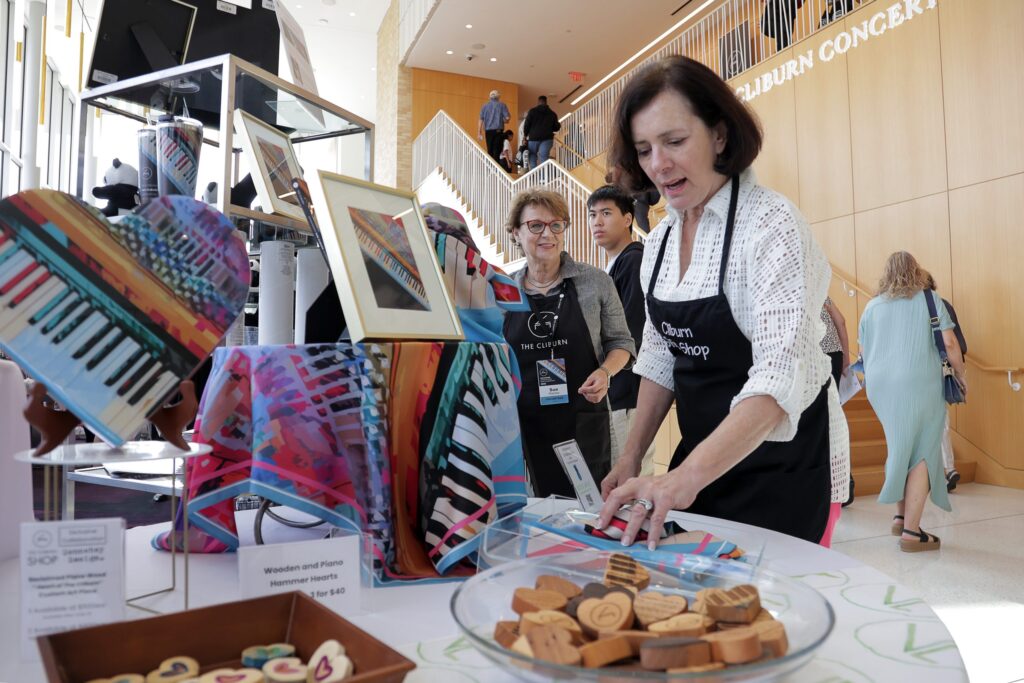The 17th Van Cliburn International Piano Competition runs through June 7. The Fort Worth Report will provide in-depth coverage of the competition. Follow the score here.
Over the course of 18 days, a slate of Cliburn competitors will give 27 concerts while vying for the gold. Behind each performance is a team of professionals keeping the wheels in motion.
Piano and stage technicians, lighting designers, hospitality workers and volunteers are just a few of the people who bring the Cliburn to life every four years. Lighting is a detail audience members might not pay close attention to, but it is important for creating the right atmosphere for audiences, said Sandra Doan, director of artistic planning for the Cliburn.
Large stages can make performers appear far away from the audience, so the goal is for lighting to make performances feel intimate and comfortable while also allowing for a little drama, she added.
“That’s the important thing,” Doan said, “to feel like you can have a one-on-one moment with the pianist and they’re not lost on the stage.”

The majority of the competition’s audience is online. While from 700 to 2,000 people might attend the Cliburn in-person at Texas Christian University or Bass Performance Hall in downtown Fort Worth, millions around the world watch online. The recent 2022 competition had massive online viewership, reaching over 60 million views across 177 countries.
Maggie Estes, the Cliburn’s director of communications and digital content, said camera setup and visuals are crucial. Camera placement provides online viewers a close-up perspective of the performance without distracting competitors.
Hospitality for Cliburn participants
Kacie Bratton, chair of the jury green room at the Cliburn, provides hospitality for the panel of judges during the competition. This entails placing catering orders for jurors’ breakfast, lunch and dinner, offering snacks and coffee during intermissions, coordinating volunteers and running errands. There are also aspects to her role people might not expect, like raising money to cover catering costs and recruiting volunteers.
“Everybody has sort of their own set of responsibilities and are really good at working together as a team,” she said.
Bratton comes from a catering and hospitality background. She started volunteering with the Cliburn to be a part of the community — and she’s had fun doing it.
“The people who are volunteering are some of my best friends,” Bratton said. “Getting to spend time with your best friends for hours a day is something that’s rare.”
Competitors also stay with host families while in Fort Worth. The organization usually chooses families based on recommendations or from a pool of previous hosts. Of the 30 families chosen each year, 15 to 20 are reinstated. The Cliburn’s volunteer host committee interviews prospective hosts and determines their fit a year and a half in advance.
Host families often bond with their competitors, sometimes traveling to see each other for holidays and concerts, Estes said.
When one competition ends, the stage is set for another
Once the Cliburn ends June 7, planning begins for the next competition in May 2029.
Performers and conductors have touring schedules to work around. Cliburn President and CEO Jacques Marquis said he called conductor Marin Alsop’s agent the week after the 2022 Cliburn to book her for this year. Jurors are also chosen far in advance and consist of nine men and women of different backgrounds from the U.S., Europe and Asia. There are different juries for the screening process and the competition itself.
Other artistic planning involves laying out the repertoire and commissioning a piece from a composer. Previous years have seen powerhouses like Leonard Bernstein and Samuel Barber contribute original works for the Cliburn. This year’s piece is by Venezuelan pianist and composer Gabriela Montero, who also serves on the jury.
“We choose them way in advance and most of the time we kind of know them,” Marquis said of the composers.
The only required pieces are the commissioned work in the preliminary round and Mozart concertos in the semifinals. The remaining works are up to the competitors. The repertoire that competitors bring to the Cliburn illustrates their artistic vision, a major component jurors look for, explained Marquis.
“It’s interesting to see how different the piece is for each of (the competitors),” he said. “I love this part of the competition.”
It’s not just Cliburn leaders who have their eyes on future competitions. Bratton said she plans to continue volunteering with hopes of hosting a pianist someday.
“To have somebody just at that level of excellence, … and kind of be a part of their world for the period of time that they’re here is pretty cool,” she said.
Getting to listen to great music while they practice, she said, is a nice bonus.
Erin Ratigan is a freelance journalist and writer specializing in narrative news features. You can find her on X @erinratigan.
Related
Fort Worth Report is certified by the Journalism Trust Initiative for adhering to standards for ethical journalism.
Republish This Story
![]()


